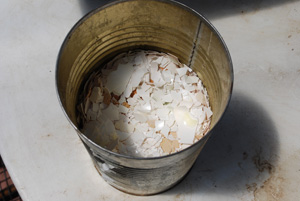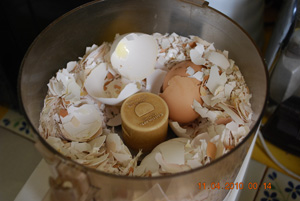Organic Calcium Sources
for Gardens
Organic calcium sources like dolomite lime and ground oyster shell are relatively cheap and readily available, but your kitchen generates free organic calcium you probably didn’t know about—eggshells.

|
|
of Free Organic Calcium © Steve Masley Click IMAGE to Enlarge |
Dried, ground eggshells are a great source of calcium for vegetable container gardens and salad tables.
Calcium is a component of plant cell walls, and it’s needed for enzyme formation and nitrate uptake. Organic calcium can also be used to help neutralize excessively acidic soils, which is especially important when you’re growing green, leafy vegetables like lettuce and spinach, or cruciferous vegetables like cabbage, broccoli, cauliflower, and kale.
Organic calcium sources include dolomite lime, calcite, ground oyster shell (oyster shell flour), and crushed eggshells.
| Soil Amendment | N-P-K | Description | Lasts | Application Rate |
|---|---|---|---|---|
Dolomite Lime |
Cheap and readily available source of Ca and Magnesium (Mg) in acidic soils. Do not use if soil Mg levels are adequate or excessive, or plant toxicity may result. If in doubt, use Calcite or Oyster Shell Flour for supplemental Ca. | 3-12 Months | In clay soil, 8.75lbs/100 sq ft raises pH 1 point In sandy soil, 2.5lbs/100 sq ft raises pH 1 point |
|
Ground Oyster Shell |
0.25-0.15-0.25 | Finely ground oyster shells. A long-term, slow-release organic Ca source. Fuels microbial growth in soil. Excellent for balancing out acidic conditions in worm bins. | 1-2 Years | 4-6lbs/100 sq ft |
| Dried, Crushed Eggshells | The trick is to dry them first in a can on top of the refrigerator. Mash down as needed, then grind to a coarse powder in a food processor. Great for seed starting mixes & cruciferous vegetables. | 3-12 Months | Up to 2lbs/100 sq ft 3Tbs/10” pot |
|
| Calcite (Hi-Calcium Lime) | Good alternative when dolomite lime is inappropriate. | 3-12 Months | 1-2lbs/100 sq ft |
Top of Organic Calcium Sources Page
Dried, Ground Eggshells
Organic gardeners know that if you just toss eggshells into the compost, they’ll disappear quickly in a hot compost pile, but they’re surprisingly resilient in cool composting systems like static compost piles or a worm composting system.

|
|
Membrane Still Intact © Steve Masley…Click IMAGE to Enlarge |
The reason for this lies in the membrane between the embryo and the shell, which has evolved to be highly resistant to microbial attack, even when the shell is cracked. As long as the membrane is moist, the embryo remains protected.
Long after the egg sizzled in the pan, the membrane under the shell continues this protective function in your compost pile or worm bin.
Eggshells eventually do break down even in cool composting systems, but you’ll have big chunks of shell left in your compost or worm castings. It will be many months before the calcium in these chunks becomes available to your vegetables.
The trick with using eggshells in the garden is to dry them out first. Once the protective membrane has dried out, the shells can soak up moisture—and microbes—from the soil, and begin to break down.
Making and Using Dried, Ground Eggshells in the Garden
Dried, ground eggshells have an NPK value around 1.2-0.4-0.1. The nitrogen content varies with the amount of egg protein left in the shells. Eggshells also contain significant amounts of calcium, as well as trace minerals.
This free organic calcium source is great in potting mixes for container vegetable gardens, for transplanting mixes to pot up seedlings, and as a way to neutralize excess acidity and provide grit in worm composting systems.
Use 1-2 Tbs per gallon of potting soil, or up to ½ cup in a 5-gallon pot.
Cruciferous vegetables, lettuce, and spinach all thrive with finely ground eggshells mixed into their soil. Tomato, pepper, and squash seedlings grown with a small amount added to their potting mix are particularly robust.
In large amounts, dried, ground eggshells can be used for raising soil pH, but it’s better to spread this valuable organic calcium source around, and use it in small amounts with many plants. Especially when organic calcium sources like oyster shell flour are available.
Organic NPK Fertilizer
(N)itrogen
|
(P)hosphorus
|
(K) Potassium
|
(Ca)
Copyright © 2009-2025, by Steve Masley, Grow-it-Organically.com
All rights reserved
HOME | About Us | Contact Us | Privacy







New! Comments
Have a question or comment about what you just read? Leave me a comment in the box below.